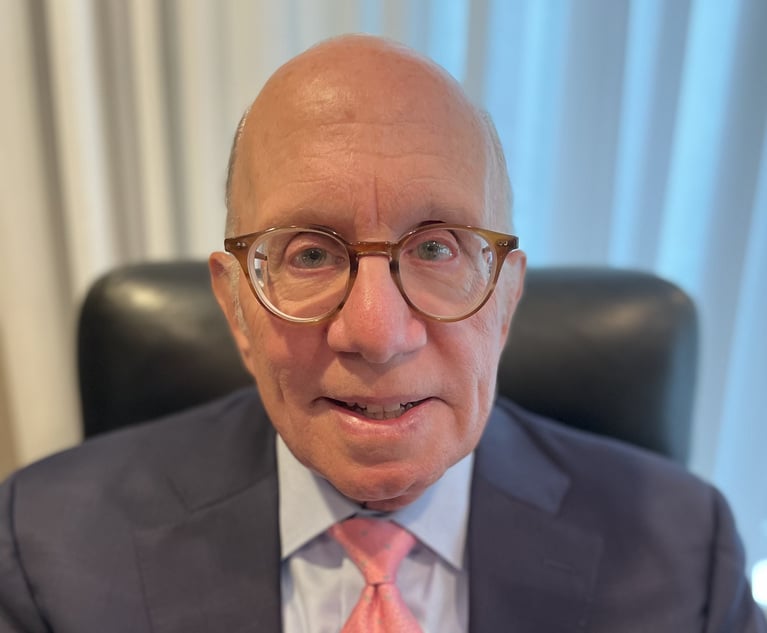 Justice Peter Tom. Photo: Rick Kopstein/ALM
Justice Peter Tom. Photo: Rick Kopstein/ALMA Rebuttal to David Saxe's Article on the Chief Judge's Inquiry Into Dissents
By falsely conflating dissents with the appellate record of a candidate for judicial certification, David Saxe has created a non-issue or a red herring to criticize the chief judge.
February 06, 2019 at 11:49 AM
9 minute read
In the interest of the court system, and with the urging of colleagues from the Appellate Division, First Department, I find it necessary to respond to and point out the inaccuracies in an article written by former Appellate Division Justice David Saxe entitled “Chief Judge's Inquiry Into Dissents Intrudes On Judicial Independence” (published in the New York Law Journal on January 24, 2019 (NYLJ 1/24/19, P. 7, Col. 1)).
In his article, David Saxe criticized Chief Judge Janet DiFiore for allegedly instituting a “new protocol” of tabulating dissents written by candidates seeking judicial certifications for additional two-year terms after reaching the retirement age of 70. The article asserts that this intrudes into “the judicial independence of the court” by purportedly discouraging judges from issuing dissents.
The fallacy in David Saxe's assertion is that the number of dissents written by applicants is not considered in the judicial certification process by the Administrative Board. Chief Administrative Judge Lawrence Marks accurately stated in his response to David Saxe's article, “the Administrative Board has never focused on the number of Appellate Division Justices' dissenting opinions.” (NYLJ January 28, 2019, P. 6, Col. 4).
The Administrative Board, consisting of the chief judge and the presiding justices of the four judicial departments of New York State, are tasked with duties including setting policies and conducting administrative matters for New York State courts, which include overseeing judicial certifications. In 2016, when David Saxe was applying for his third and final two-year term of certification, I was the acting presiding justice of the First Department and a member of the Administrative Board. Hence, I was in a position to know the factors relating to certification that were actually considered and those that were not. For the record, Justice Saxe was re-certified.
In screening candidates for judicial certification, the Administrative Board, among other considerations, reviews the appellate record of candidates. This is clearly a relevant performance issue. For judicial candidates, this would include consideration of their appellate record consisting of the number of affirmances, reversals and modifications pertaining to the candidate's decisions and opinions that go up on appeal.
To reiterate, this process does not include inquiry into the number of dissenting opinions written by the applicant. Since dissents are not even a subject of inquiry, obviously they have no bearing on the outcome of any application for certification. Thus, David Saxe's criticism of the chief judge's alleged inquiry into an appellate court candidate's dissents is without basis and is simply a false premise.
It is appropriate and beneficial for the Administrative Board to review a candidate's appellate record. It reflects on the candidate's judicial performance in analyzing and judging cases. A candidate's consistent pattern of affirmances suggests a thoughtful and skilled jurist who carefully analyzes the law and the facts. A chronic history of reversals suggests otherwise. No candidate is entitled to certification or re-certification. Candidates who demonstrate a record of sound judicial performance are certified to continue to serve.
Chief Judge DiFiore has implemented a more robust approach for the review of applicants for judicial certification than had prior administrations. This is not a reflection on past practices. Rather, it reflects a budgetary reality and a commitment to high standards of accountability. It costs approximately $1 million for each two-year judicial certification for the judge, staff and chambers along with ancillary expenses.
David Saxe in his article states that he learned of the Administrative Board's alleged inquiry into dissents during his final certification process in 2016, when I, as acting presiding justice, asked him, “to prepare a list of all the items making up my appellate average” including a “list of my dissents.” This is categorically false; this never happened.
Since I was responsible for reviewing and reporting to the Administrative Board on applicants for judicial certification from the First Judicial Department, my research into the candidates' records was undertaken personally and independently and necessarily relied on objective sources. I did not ask David Saxe for his statistical numbers or any other information concerning his qualifications.
In fact, the compilation of data concerning his and other candidates' appellate records (i.e.: affirmances, reversals and modifications) was exclusively conducted in my chambers with the assistance of my staff and the librarian of the Appellate Division.
His statement that I, “confirmed that the purpose of this statistical edict was to impede what was perceived as unnecessary dissents, which, when they became the subject of successful motions for leave, added unnecessarily to the work of the Court of Appeals,” is a falsehood. There is no reason why I would “confirm” this when the dissents written by a candidate for judicial certification are not even considered during the evaluation process.
By falsely conflating dissents with the appellate record of a candidate for judicial certification, David Saxe has created a non-issue or a red herring to criticize the chief judge. The implication that the chief judge is somehow cutting corners to ease her court's work is far from the truth. Judge DiFiore's record speaks volumes. As chief judge, she has judicial duties as a member of the bench while also entrusted to discharging the increasingly complex responsibilities of administering one of the most active and cumbersome court systems in the country.
A few words must also be said about the chief judge's extensive administrative work and her accomplishments so far. The chief judge's “excellence initiative” has dramatically improved court efficiency throughout the State of New York with demonstrated positive results during the short time she has been chief judge. The reports on the State of the Judiciary for 2017 and 2018 amply establish the efforts taken by court administrators under the leadership of Chief Judge DiFiore in modernizing our courts and streamlining procedures and processes while also serving the needs of New York's citizenry.
We are all too aware of the adage that justice delayed often is justice denied. The reasons for backlogs in some courts have been identified and addressed, often with help of reassigned personnel and implementation of improved procedures. Several courts, especially in criminal courts and family courts in and outside of New York City, have seen significant reductions in case backlogs, while processing of incoming cases has been significantly streamlined in many courts.
Anyone reviewing the reports since the excellence initiative was announced can see the benefits and successes of the significant administrative reforms that have been undertaken. We should see continued progress in the improvement of our court system for 2018 when the chief judge gives her State of the Judiciary on February 26, 2019. This is an ongoing team effort.
The criticism against the chief judge and the Administrative Board is unfounded and puzzling at a time when major systemic efforts are ongoing to improve court operations. It is curious that David Saxe finds the need to complain about the process, two years after his final certification.
There are a number of other representations in David Saxe's article that need to be corrected. He stated that the putative new policy of the chief judge of factoring in dissents during the judicial certification review “became the talk of the lunchroom at the First Department for days.” At the time, I was acting presiding justice. Since I was present at most of those lunches and communicated frequently with my judicial colleagues, this is a surprise to me. I heard no mention of this putative policy of the chief judge either in or outside of the lunchroom.
If the First Department justices were so concerned, they would have scheduled this topic for discussion at our weekly agenda conference, as we often do when important issues affect our court and justices. No one ever brought up the subject. Since certification is a topic of interest among my colleagues, myself included, it is odd that this issue evaded formal or informal discussions. David Saxe's description that “there was widespread concern among my then colleagues,” regarding the chief judge's alleged new policy, lacks both merit and support.
Finally, as to David Saxe's proposition that my appellate colleagues will somehow be reluctant to express their professional opinions in separate writings, for the record – the Justices of our court have no hesitation whatsoever in penning a dissent. These are high caliber, independent judges with the utmost integrity and honesty.
If a justice in our court has a strong position on a legal issue and is on the minority side of the panel, that judge will draft a dissent with no hesitation. I, myself, have written a good number of dissenting opinions during my tenure as a Justice of the Appellate Division. It may be recalled that many of the dissents of a famous dissenter, Justice Oliver Wendell Holmes, often, eventually, became law.
A dissent, rigorously undertaken, not only encourages the majority to sharpen its analysis but may also bring to view an important principle of law which may have future salience. Of course, there also is great value in the court speaking with a unified voice on important issues of law, to which end the court's leadership may encourage a reframing of a disputed issue or a judicious narrowing of the analysis.
This challenge is borne by our chief judges. This presents an ongoing tension, but likely a beneficial one as courts continue to grapple with the issues of the day. What I can say with certainty, however, is that the right of a justice in our court, or in any appellate court in New York, to independently evaluate a case and dissent from the conclusions of the majority, is and will remain unimpeded.
I do not think David Saxe needs to be “afraid that the requirement of this seemingly harmless statistic portends a change of life for my old court.” The court is doing quite well and will continue to do so.
Peter Tom is an associate justice in the Appellate Division, First Department.
This content has been archived. It is available through our partners, LexisNexis® and Bloomberg Law.
To view this content, please continue to their sites.
Not a Lexis Subscriber?
Subscribe Now
Not a Bloomberg Law Subscriber?
Subscribe Now
NOT FOR REPRINT
© 2024 ALM Global, LLC, All Rights Reserved. Request academic re-use from www.copyright.com. All other uses, submit a request to [email protected]. For more information visit Asset & Logo Licensing.
You Might Like
View All
Patent Trolls Come Under Increasing Fire in Federal Courts

Why Is It Becoming More Difficult for Businesses to Mandate Arbitration of Employment Disputes?
6 minute readTrending Stories
- 1Judge Skips Over Sanctions in Talc Bankruptcy: 'That’s A No'
- 2Hit by Mail Truck: Man Agrees to $1.85M Settlement for Spinal Injuries
- 3Anticipating a New Era of 'Extreme Vetting,' Big Law Immigration Attys Prep for Demand Surge
- 4Deal Watch: What Dealmakers Are Thankful for in 2024
- 5'The Court Will Take Action': Judge Upbraids Combative Rudy Giuliani During Outburst at Hearing
Who Got The Work
Michael G. Bongiorno, Andrew Scott Dulberg and Elizabeth E. Driscoll from Wilmer Cutler Pickering Hale and Dorr have stepped in to represent Symbotic Inc., an A.I.-enabled technology platform that focuses on increasing supply chain efficiency, and other defendants in a pending shareholder derivative lawsuit. The case, filed Oct. 2 in Massachusetts District Court by the Brown Law Firm on behalf of Stephen Austen, accuses certain officers and directors of misleading investors in regard to Symbotic's potential for margin growth by failing to disclose that the company was not equipped to timely deploy its systems or manage expenses through project delays. The case, assigned to U.S. District Judge Nathaniel M. Gorton, is 1:24-cv-12522, Austen v. Cohen et al.
Who Got The Work
Edmund Polubinski and Marie Killmond of Davis Polk & Wardwell have entered appearances for data platform software development company MongoDB and other defendants in a pending shareholder derivative lawsuit. The action, filed Oct. 7 in New York Southern District Court by the Brown Law Firm, accuses the company's directors and/or officers of falsely expressing confidence in the company’s restructuring of its sales incentive plan and downplaying the severity of decreases in its upfront commitments. The case is 1:24-cv-07594, Roy v. Ittycheria et al.
Who Got The Work
Amy O. Bruchs and Kurt F. Ellison of Michael Best & Friedrich have entered appearances for Epic Systems Corp. in a pending employment discrimination lawsuit. The suit was filed Sept. 7 in Wisconsin Western District Court by Levine Eisberner LLC and Siri & Glimstad on behalf of a project manager who claims that he was wrongfully terminated after applying for a religious exemption to the defendant's COVID-19 vaccine mandate. The case, assigned to U.S. Magistrate Judge Anita Marie Boor, is 3:24-cv-00630, Secker, Nathan v. Epic Systems Corporation.
Who Got The Work
David X. Sullivan, Thomas J. Finn and Gregory A. Hall from McCarter & English have entered appearances for Sunrun Installation Services in a pending civil rights lawsuit. The complaint was filed Sept. 4 in Connecticut District Court by attorney Robert M. Berke on behalf of former employee George Edward Steins, who was arrested and charged with employing an unregistered home improvement salesperson. The complaint alleges that had Sunrun informed the Connecticut Department of Consumer Protection that the plaintiff's employment had ended in 2017 and that he no longer held Sunrun's home improvement contractor license, he would not have been hit with charges, which were dismissed in May 2024. The case, assigned to U.S. District Judge Jeffrey A. Meyer, is 3:24-cv-01423, Steins v. Sunrun, Inc. et al.
Who Got The Work
Greenberg Traurig shareholder Joshua L. Raskin has entered an appearance for boohoo.com UK Ltd. in a pending patent infringement lawsuit. The suit, filed Sept. 3 in Texas Eastern District Court by Rozier Hardt McDonough on behalf of Alto Dynamics, asserts five patents related to an online shopping platform. The case, assigned to U.S. District Judge Rodney Gilstrap, is 2:24-cv-00719, Alto Dynamics, LLC v. boohoo.com UK Limited.
Featured Firms
Law Offices of Gary Martin Hays & Associates, P.C.
(470) 294-1674
Law Offices of Mark E. Salomone
(857) 444-6468
Smith & Hassler
(713) 739-1250








